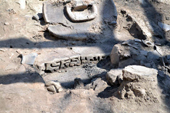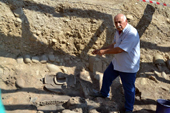
Archeological excavations on world-important Grakliani hill continues
By Gvantsa Gabekhadze
Monday, August 24
Tbilisi States University has dismissed speculations over the suspension of archeological excavations on Grakliani hill, eastern Georgia, in the Kaspi Municipality, where a couple of days ago a 2,700 year old unidentified writing was found that might change sections of both Georgian and the world history.
Head of the Institute of Archeology of Tbilisi State University and the chair of the expedition Vakhtang Licheli told the media was inaccurate when it announced the suspension of exploring the site owing to financial complications.
Licheli stressed that the State University allocated annual funds for the researches and, in addition, the National Agency for Cultural Heritage Protection also contributed to the job.
In terms of recently discovered writing archeologists stated that it had no analogue and it would become an extremely interesting piece for foreign scientists and explorers.
The writing was inscribed on the 7th century temple dedicated to a fertility goddess.
“The discovery is very likely to change Georgian history and will seriously attract the international interest,” Georgia’s Minister of Culture Mikheil Giorgadze said and noted that an open museum would be arranged on the scene that enables visitors to observe artifacts and archeological excavations.
Licheli said that through the “excellent discovery” Georgia gathered the elite of the civilizations that enjoyed their written languages thousands of years ago.
“The writings on the two altars of the temple are really well preserved. On the one alter several letters are carved in clay while the second altar is wholly covered with writings,” Licheli said.
The Glakliani hill depicts a non –stop 300,000 year chain of human development from the stone era to the antique period.
Ten layers of the site have been excavated up to now through which various ancient weapons, objects of worship and pharmacological devices revealed.
A printing device of the 4th century BC was described as one of the most important discoveries of the area which was found in South Mesopotamia.
Archeologists also found a gold disc dating back to the 5-6th century BC. The same disc is preserved in Iran.
Several rooms for worship and special mills and hand-mills also attracted the interest of archeologists. It is believed that the wheat aimed for baking bread for gods was ground there.
An alter platform discovered in the hill has no analog in the world.
Archeological excavations on the Grakliani hill were launched in 2007.


